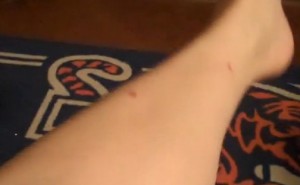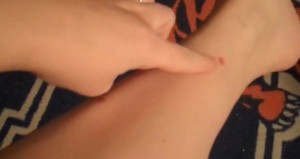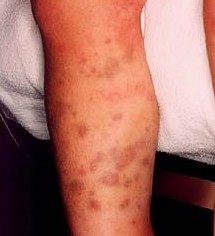Petechiae rash is characterized by red to purple spots on the body which are primarily caused by broken capillary blood vessels resulting to blood leakage. It measures from 1-2mm to about half an inch small. They visibly look like small red dots. If you have a rash on your skin and want to find out if this is Petechiae rash, there’s a quick test to determine that. Put pressure on your skin with your thumb on the area where the spots are and if those spots are still visibly red after applying pressure, this would confirm that what you have are Petechiae rash. Another easy test is the glass test in which you will apply pressure on the site of the rashes with the use of a glass and if the rashes can still be seen, this would confirm that it is a Petechiae rash. These rashes can be harmful and life threatening so medical attention should be given right away.
Causes and Treatment of Petechiae Rash
There are plenty of causes for the formation of Petechiae rash on skin. A minor cause could be due to trauma to the skin leading to the breakage of the capillary blood vessels. Examples of the instances that could cause trauma to the capillaries are extreme coughing or vomiting and intense crying. These could lead to the formation of Petechiae rash on the upper region near the chest and up to the face. Tight clothes can also cause this type of rash. These are, however, the minor causes of Petechiae rash. More often, Petechiae rash is a sign or a symptom of a more serious disease as it could indicate low platelet count. These are the serious illnesses that can present petechiae rash:
• Meningococcemia
This disease is due to the invasion of the harmful bacteria called Neisseria meningitides. If not given medical attention, this could be fatal. One common symptom of this is fever and formation of petechial rash as the bacteria destroys the blood capillaries. Other symptoms would include headache, congestion, nausea, vomiting and muscle pain. Note that this disease is highly contagious so the person who has this should be isolated in a hospital.
o Treatment for Meningococcemia
To decrease the risk of transmission, it is advisable to have good hygiene. Constant hand washing is also helpful.
Seek medical attention right away.
Upon admission in the hospital, intravenous antibiotics should be given. Penicillin G is the most used antibiotic for meningococcemia. For the surrounding people in contact with the victim, Rifampicin is the best prophylactic for them.
• Rocky mountain spotted fever and Lyme diseases–
These illnesses are caused by tick bites. When the tick bites on the person’s skin, it immerses directly on the blood stream causing a leak on the capillaries, thus, the formation of Petechiae rash. Both diseases share more or less the same symptoms, which would include fever, chills, headache, nausea and vomiting, pain in the abdomen, muscle pain, and sometimes delirium may also develop.
Treatment for Rocky mountain spotted fever and Lyme diseases
Seek medical attention right away.
Antibiotics should be given immediately. Common antibiotics administered to the patient would include doxycycline, tetracycline and chloramphenicol.
Prevention is better than cure so it would be advisable to wear long sleeved shirts when going outdoors. Pets may also carry ticks so it would be best to bathe your pets at a regular basis.
• Kawasaki disease
Kawasaki disease may be caused by bacteria or virus. There is still no specific cause for this illness though. This is one of the most serious diseases to arise in children between 4 and 9 years old. If this is not diagnosed and treated promptly, it could result to serious damage to the victim’s heart. Some of the symptoms are high fever for five straight days, redness of eyes, enlarged lymph nodes, cracked red lips, redness of the fingers and toes, peeling of the skin of the fingers and Petechiae rash that’s detected greatly on the hands and feet.
o Treatment for Kawasaki disease
Appropriate diagnostic tests such as complete blood count and electrocardiogram would help confirm this illness because children with Kawasaki disease can develop aneurysms.
Victims should be admitted to the hospital and given intravenous gamma globulin and a high dose of aspirin.
• Toxic shock syndrome
– This disease is mainly caused by the toxic substance produced by staphylococcus aureus or the Streptococcus bacteria. These bacteria are found normally on the skin but instances like inserting vaginal contraceptives into the orifice may allow the bacteria to enter the system and spread wildly into the blood stream. Symptoms of this illness are high fever, constant chills, sore throat, muscle pains; and sometimes nausea and vomiting are experienced as well. The toxins of the bacteria can cause low blood pressure resulting to shock to the patients and may also lead to disorientation and eventually organ failure. Petechiae rash would form at the onset of the symptoms.
o Treatment for Toxic Shock Syndrome
The person with toxic shock syndrome should immediately be confined in a hospital and given proper medical care. When stabilized, the patient should be confined in intensive care unit for constant monitoring.
Antibiotics should be given to kill the bacteria.
With every serious disease, the most important thing to do is to seek professional medical help. The doctor should then conduct diagnostic procedures to determine the disease. From thereon, he/she can find a regimen for the appropriate treatment for the disease.
Prevention of Petechiae rash
Most of the serious diseases that manifest petechiae rash are caused by the invasion of bacteria and viruses. That alone should serve as a sign that in order to prevent the diseases from happening, a person should have good hygiene and a clean environment. Constant hand washing greatly helps in preventing bad bacteria and viruses from invading the body.
When symptoms are found, take immediate action before it becomes grave. Petechiae rash may seem harmless and could be caused by simple things like tight clothing and extreme coughing but it could also be a symptom of a more serious disease.



I get this rash after a long hike on a hot day. Usually my legs swell a little during the hike. My lower legs, calves, start showing as a red discoloration or rash then the legs look like broken blood vessels. My doctor did the test bu applying pressure to the rash and it did not change in color. She did a blood test and low platelet counts and the test were negative. The rash is not raised. It does sometimes burn or itch as it start turning bright red in color. Can leg swelling cause this petechia? How do I prevent it in the future?